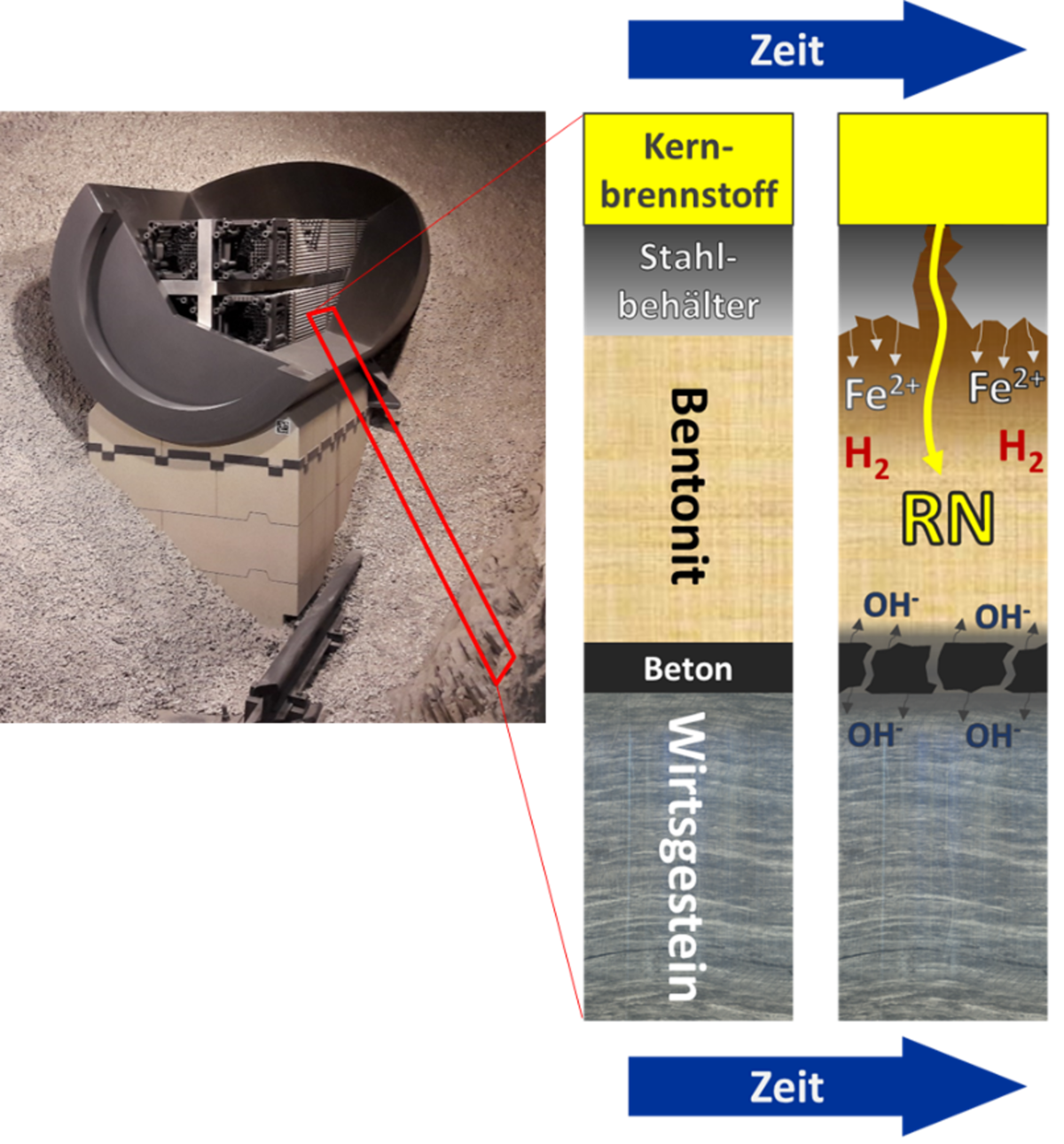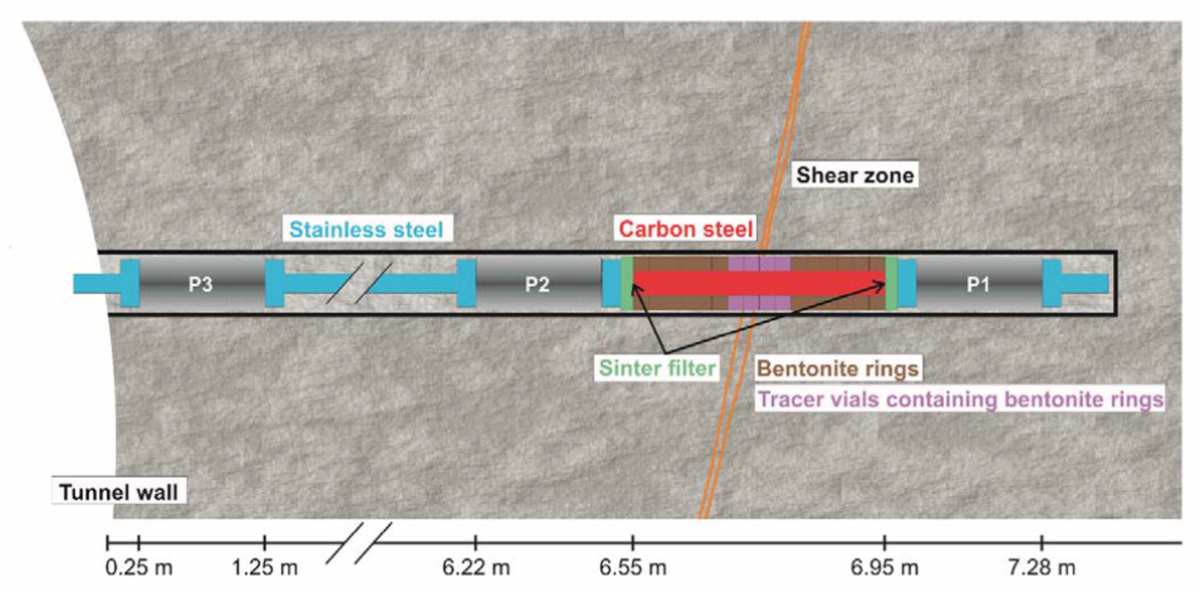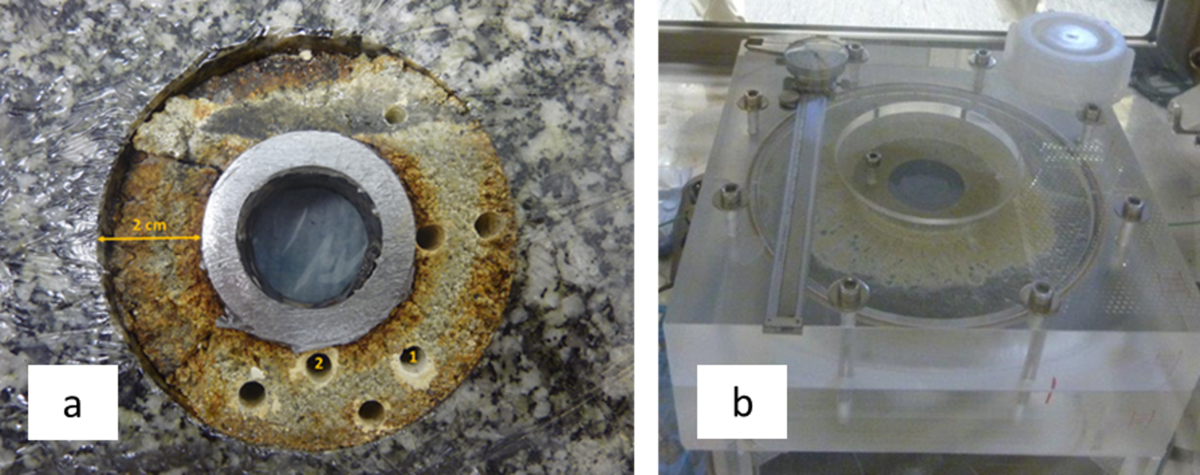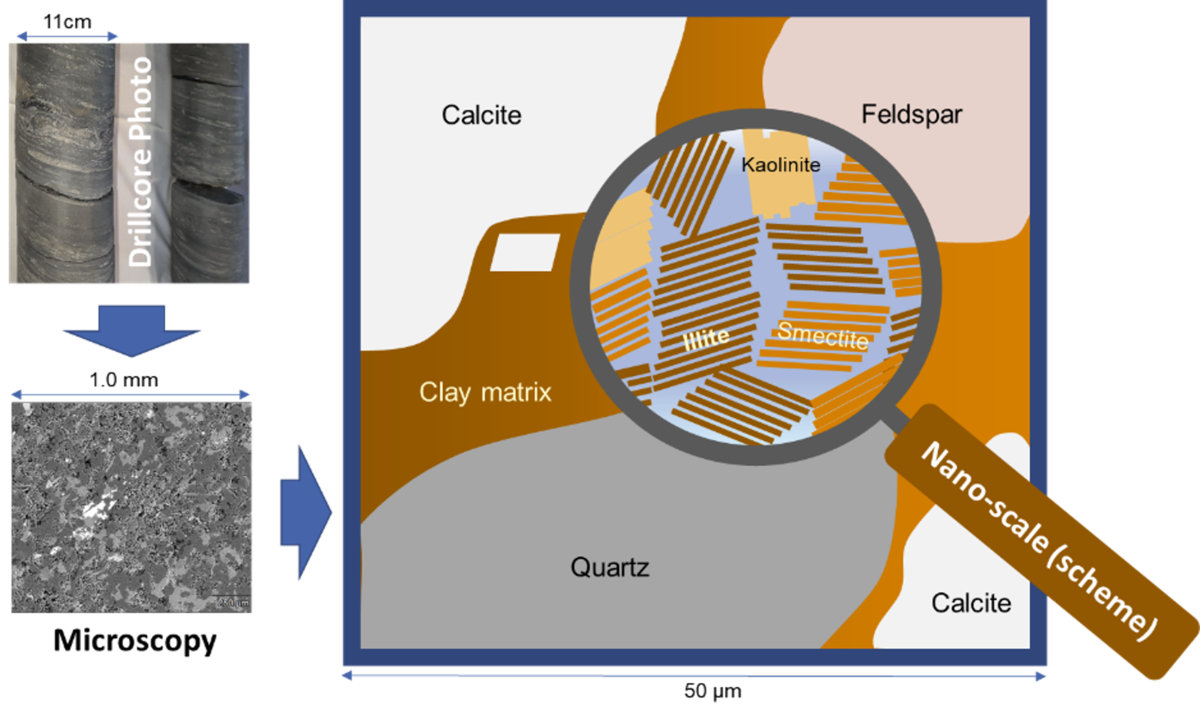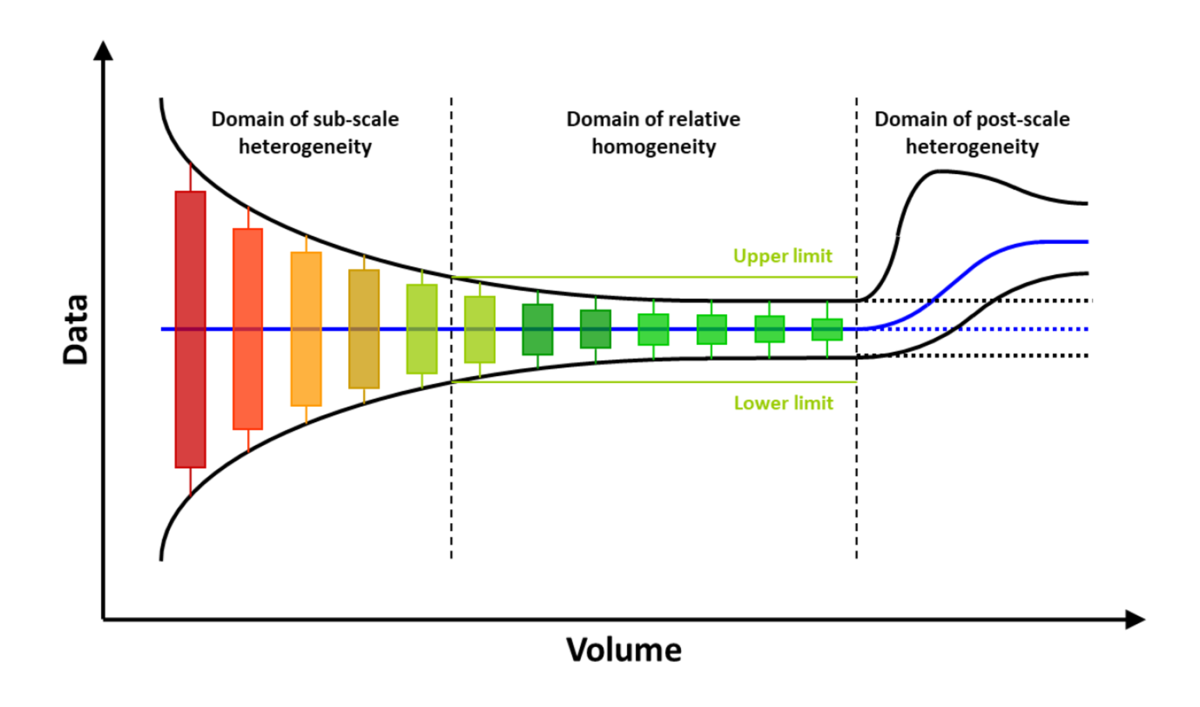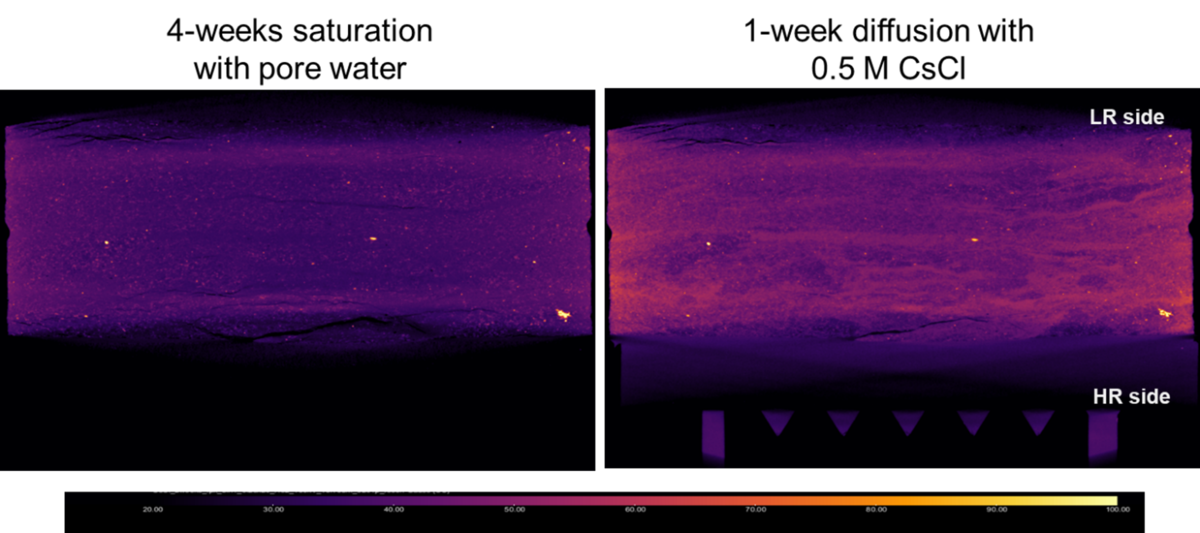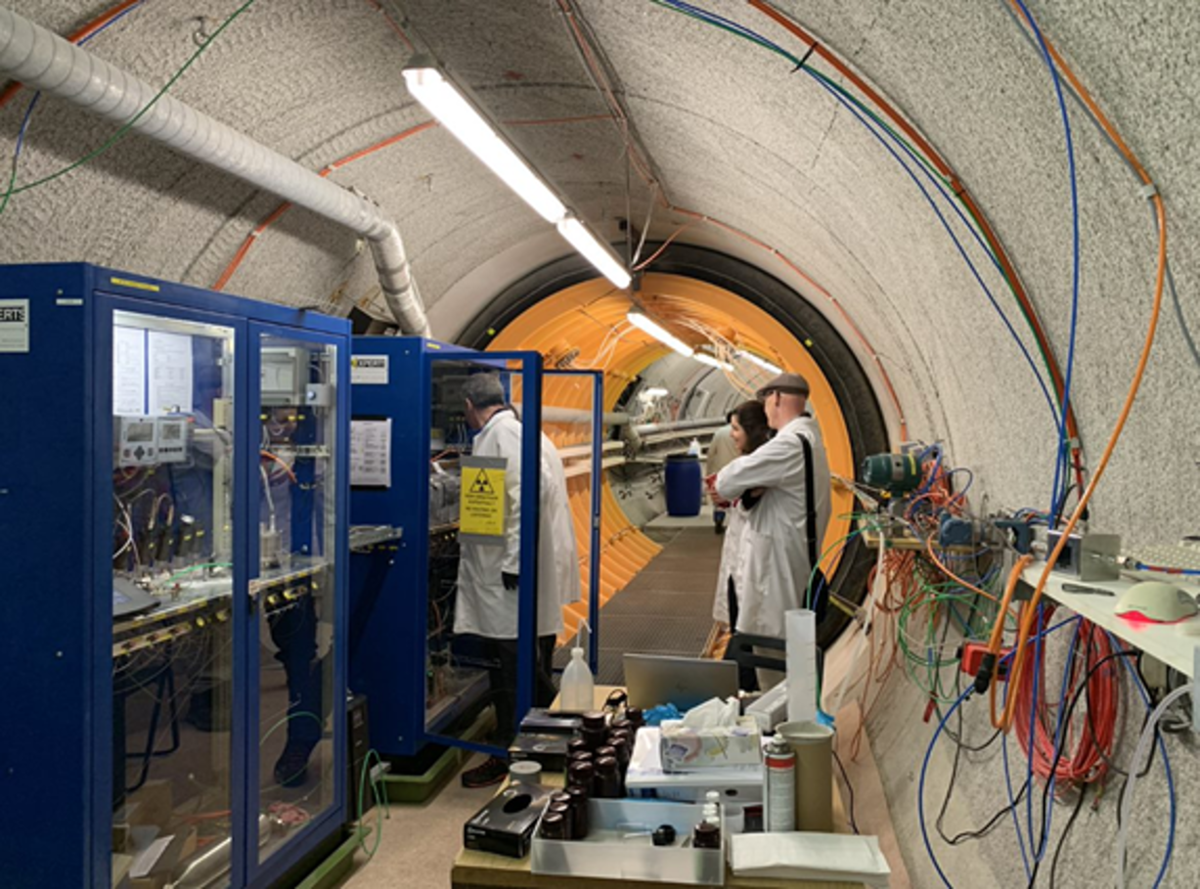Radionuclide migration in nuclear waste repository barriers
Investigations on radionuclide migration in waste repository barriers at INE focus on materials and processes in the near and far field around repositories for radioactive waste, which may impact radionuclide transport and thus, the safety of a repository. Over the long periods of time during which the repository must meet high safety standards, it is to be expected in the host rocks clay and “crystalline” that groundwater will penetrate into the near-field of the repository and initiate corrosion and alteration processes. For a realistic consideration of radionuclide migration, it is essential to understand alteration processes and to be able to quantify their influence on the transport and retention processes. In the repository near-field, the focus is on two processes. Firstly, the alteration of bentonite in the presence of corroding iron and its influence on radionuclide sorption and diffusion processes, and secondly, the diffusion and erosion behavior of bentonite (-> link to subchapter) in fractured host rocks, which can release clay colloids that accelerate radionuclide transport under unfavorable conditions. Of course, the properties of undisturbed bentonite are also considered (https://link.springer.com/chapter/10.1007/978-3-031-53204-7_3 ).
Main research topics related to the far field of a repository are: Sorption and diffusion in heterogeneous clay rock in the presence and absence of temperature gradients and the colloid-mediated transport of radionuclides in fractured rock, which are investigated both in the laboratory and on a large scale in the underground research laboratories in Mont-Terri and Grimsel.
Fig. 1: (left) Demonstration-cross section through a repository near-field, exposition in the underground research laboratory Mont-Terri (CH, Photo: F. Heberling). Displayed schematically on the right is the setup of a multi-barrier system for a waste repository for high-level radioactive waste and its temporal evolution, during which alteration processes may change the properties of the barrier-materials, and, thus affect the radionuclide-(RN-)-migration.
Contact:
|
+49 721 608 24782 |
+49 721 608 22233 |
Main points of interest:
• Transition zone: Steel container - bentonite
Alteration of bentonite in the presence of corroding iron, and its impact on Radionuclide sorption and diffusion
In the near-field of a repository in clay rock (and similarly in “crystalline” rock), a number of processes are expected to occur after closure of the repository that will lead to alteration of the near-field materials. Over the course of several decades to centuries, the repository near-field will become saturated with groundwater. In contact with water, corrosion processes set in on steel container surfaces, which quickly consume the remaining oxygen. After the oxygen has been consumed, steel corrosion continues anoxically, producing hydrogen and Fe(II). All this happens during the so-called thermal phase of the repository, which can last several hundred to thousand years, during which the near-field heats up to 100°C and then cools down again to ambient temperature. If container corrosion continues for several thousand years, various scenarios assume that the first containers fail after around 10,000 years. During this period, bentonite from the geotechnical barrier may react with the Fe(II) released by steel corrosion at elevated temperatures and under relatively reducing conditions (dissolved hydrogen).
At INE, experiments on the alteration of bentonite in the presence of corroding iron are being conducted in an attempt to mimic this scenario. The alteration of clay minerals contained in the bentonite (montmorillonite) is studied with a focus on the diffusion and sorption behavior of radionuclides in the altered bentonite, with the aim of gaining a better understanding of how radionuclides released from the waste may spread and migrate towards the biosphere.
Results from experiments with bentonite suspensions at 90°C indicate extensive recrystallization of montmorillonite and the formation of Fe(II)-rich serpentine minerals, providing clues to possible extensive changes in bentonite properties such as swelling capacity and ion exchange behavior. Sorption experiments with Cs-137 indeed indicate reduced sorption coefficients of the Fe(II)-altered clays. Similar experiments with compacted bentonite show less strong alteration (montmorillonite is retained). Here, the diffusion coefficients for HTO and Cl-36 decrease while the porosity remains about constant, which indicates a slowdown in radionuclide dispersion from the repository compared to a geotechnical barrier made of fresh bentonite.
Comparable bentonite alteration processes were also detected in samples from underground laboratory experiments (IC-A, Mont-Terri). In addition to serpentine minerals and other Fe-silicates, iron oxides (especially magnetite) and carbonate phases were formed (Fig. 2).
Fig. 2: (left) Bentonite sample from the underground research laboratory experiment IC-A in Mont-Terri, after more than 5 years of contact with a steel coupon. Detailed analyses of the altered bentonite are shown on the right. Above: Iron analysis with synchrotron µ-XRF. Spectral point analyses revealed indications of serpentine minerals and iron oxides (magnetite) as alteration products. Below: Noticeable in the SEM-EDX analysis are calcium accumulations (light blue) near the steel surface, which can be attributed to calcite precipitation due to pH increase or water consumption during corrosion. Iron phases are shown in red and green..
Contact:
|
+49 721 608 24782 |
• Bentonite: diffusion-, swelling- and erosion behavior
Diffusion- and erosion behavior of bentonite
A bentonite engineered barrier system is envisaged to be used in deep geological repositories in granitic host rock to retard the transport of radionuclides possibly released from corroded canisters to the geosphere. At the Grimsel Test Site (GTS), the NAGRA´s generic URL in Switzerland, we investigate the stability of compacted bentonite and radionuclide diffusion through it under geochemical conditions representative of a deep geological repository in crystalline host rock. In the frame of the international Colloid Formation and Migration (CFM) Project, the long-Lerm In-situ Test (LIT) featured a source of compacted FEBEX bentonite rings spiked with radionuclide tracers, among them 99Tc, 233U, 237Np, 242Pu and 241Am, surrounding a carbon steel mandrel and emplaced into a water conductive shear zone of the GTS (Fig. 3). LIT lasted 4.5 years and it was accompanied by a corresponding laboratory mock-up test in which radionuclide diffusion was investigated through the same compacted FEBEX bentonite placed between two Plexiglas plates intersected by a 1 mm artificial fracture (Fig. 4). Post-mortem analysis is being carried out to elucidate the influence of the corrosion products of the carbon steel mandrel as well as of the geochemical conditions of the granodiorite host rock on radionuclide diffusion in the LIT compared to the simpler laboratory conditions of its mock-up.
https://www.grimsel.com/gts-projects/cfm-section/cfm-lit-long-term-in-situ-test
Fig. 4: Slice of the over-cored LIT (a) showing the aged bentonite surrounding the carbon steel mandrel, enclosed in the granodiorite rock of the Grimsel Test Site. Samples of bentonite are drilled in order to perform mineralogical analysis and investigate secondary mineral phases at the boundary between carbon steel and bentonite as well as in other positions of the bentonite ring. Set-up of the mock-up test (b) depicted inside an Ar glove box of the radiation-controlled area of KIT-INE. Bentonite erosion due to the saturation of the bentonite with Grimsel ground water produced a gel that is visible as a halo surrounding the inner bentonite ring.
Contact:
|
+49 721 608 22233 |
• Sorption- and diffusion processes in clay host rock
Sorption and diffusion in heterogeneous clay rock
In recent years, work on the host rock clay at the INE has focused primarily on Opalinus Clay from Mont-Terri, and in particular on quantifying the heterogeneity of the sandy facies of Opalinus Clay and investigating the potential influence of heterogeneity on radionuclide migration. The background of the investigations is the expected heterogeneity of potentially suitable clay host rocks in Germany, which makes it necessary to find ways to deal with rock heterogeneities in safety assessments for deep geological repositories.
Clay rocks, as natural, usually layered sedimentary rocks, exhibit various forms of heterogeneity on different scales and in different directions, as shown schematically in Fig. 5.
Investigations at INE in recent years have shown that the heterogeneity of clay rocks is not easy to grasp. When trying to quantify the heterogeneity via a representative elementary volume (REV), the heterogeneity changes depending on the parameter considered (e.g.: visual characterization, mineralogy, radionuclide sorption). Visually, differences between clay rich areas and concretions rich in sand and limestone can be recognized easily. Accordingly, an average over an area > 1m along a drill core (approximately perpendicular to the stratification) would need to be taken in order to obtain a uniform appearance with < 10 % deviation from neighboring areas. However, parallel to the bedding planes, drill cores drilled at a distance of 20 m show an almost identical appearance, so that an extraordinary homogeneity can be assumed along the bedding planes.
In a mineralogical characterization, it is noticeable that completely different REVs are determined on the microscopic scale (approx. (340 µm)3) and on a macroscopic scale, where a rock sample of approx. 100 cm3 may be regarded as representative of a subfacies or sedimentary layer.
Good news for safety considerations is that heterogeneity has even less influence on the important factor of radionuclide sorption. Here, rock samples in the order of 10 cm3 (8-27 cm3) already provide representative results for the entire sandy facies of the Opalinus Clay. A conceptual representation of the determination of a REV and the associated range of relative homogeneity is shown in Fig. 6. It illustrates the scale dependence of a REV and the dependence on often arbitrarily selected or method-dependent limits of data uncertainty that are used to determine a REV.
Fig. 6: Concept of the statistical determination of a representative elementary volume (REV). As the sample size increases, the data scatter decreases until all samples provide similar results within certain limits and can therefore be considered representative. If the sample volume reaches a size where neighboring mineral grains / sediment layers / facies are sampled (depending on the application scale), deviating results are obtained again.
The investigations into heterogeneous clay rocks continue and are being extended to include diffusion experiments both in the Mont-Terri underground laboratory (https://www.mont-terri.ch/en) and on a laboratory scale. The effects of different temperatures and temperature gradients will also be taken into account. Figure 7 shows exemplarily first result of a µCT scan of a clay rock before and after contact with a concentrated CsCl solution. Cs+, which is known to interact primarily with clay minerals, shows clearly a heterogeneous distribution (bright pink areas) within the clay-rock disc after diffusion.
Fig. 7: Clay rock disc (2.5 cm diameter, 1 cm thick) embedded in epoxy and scanned with µCT before and after contact with 0.5 M CsCl solution. After diffusion, Cs+ shows a clearly heterogeneous distribution within the clay rock. The absolute color scale sets a value of 20 to the epoxy and a value of 100 to the brightest dense mineral particles (barite/celestine).
Contact:
|
+49 721 608 24782 |
• Colloid mediated radionuclide transport in granitic host rock
Radionuclide transport in “crystalline” host rocks
In the event of failure of the bentonite engineered barrier system, radionuclide migration in crystalline rock may occur via advective transport through water conductive features. In Grimsel groundwater bentonite colloids are particularly stable, due to the high pH of ca. 9.7 and the low ionic strength of ca. 1 mM. These conditions are ideal to simulate the possible future intrusion of glacial melt-water or low mineralized meteoric water into a deep geological repository in crystalline host rock. With a series of in-situ radionuclide tracer tests starting in 2001 and carried out through a shear zone in the granodiorite rock of the Grimsel Test site (Fig. 8 and 9), we have observed that i) U(VI) and Np(V) migrate mainly as dissolved species, while Th(IV), Pu(IV) and Am(III) are transported primarily adsorbed onto bentonite colloids; ii) there is an inverse correlation between the residence time of the spiked Grimsel ground water in the chosen hydrological dipole of the shear zone and the radionuclide as well as bentonite colloids recovery. In-situ tests in a region of the shear zone intersected by lamprophyre intrusions are presently planned in the frame of the CFM Project. In preparation and support of such forthcoming in-situ tests, we perform laboratory experiments to characterize the mineralogy of the lamprophyre intrusions and compare the sorption capability of lamprophyre with granodiorite towards 99Tc and U, Np, Pu and Am.
https://www.grimsel.com/gts-projects/cfm-section/cfm-lit-long-term-in-situ-test.
Contact:
|
+49 721 608 22233 |

